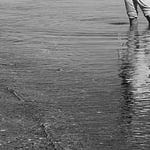Only skip what’s on the shore. What comes in should go out to come in again.
Every rock has a maximum number of skips, a maximum distance it’s able to go. The possibility lies bare before you if only you can just get the throw right.
Have empathy before the throw. Pick up the rock, feel the heft, the sides. How hard to throw it? How much spin? What angle? Let its nature inform your throw.
Don’t push it. The harder you try to over-extend the distance, or the number of skips, the worse the outcome. You can’t exceed the possible. Accept the rock for what it is and the throw will succeed.
Sometimes your finger slips, or the wind or the water gets quirky at a bad time. Some throws are just duds. That’ll happen with good and bad rocks alike. In which case, what you do is pick up the next one and try again.
Mike first taught me how to skip stones, although he didn’t know it at the time. I certainly did.
We were by the pond up from his house. His dad owned a landscaping business and had an honest-to-God Green Acres style property that turned golden in the aftrenoons. We’d usually get into the hay loft and pretend to be in the Marines, jumping down to the cow pens but that afternoon, we hung out by the pond. Mike was so good at skipping, he could clear the pond with every throw—he’d hurl a stone, it would skim the surface and bounce off the shore. Then he’d walk around to the other side and skip it back. During baseball season, Mike was always on the better teams.
I tried to copy his throwing but the stones just made an awkward clunk in the water. He eventually lost interest and headed for the barn, but before he left, he told me I was throwing them wrong. It had to be a sidearm throw, like Satchel Paige.
I could manage a couple of skips after that, and when I got really lucky, I could let one rip and hit the shore.
There’s this cold spring in the center of West Virginia, somewhere close to the cabin owned by John and Jamie's parents. John was a year older than I, and Jamie two years younger. We grew up together, and occasionaly visited the cabin during summer vacations. Down tracks that seemed to date as far back as Pangea, we’d walk the rails to see how far we could make it without falling off. Past cabins and houses that were long since abandoned, through an entire afternoon of walking, we found the emerald blue.
It was a spring as impossibly clear and as sapphire-saturated as anything I’ve seen since. It was a perfect circle, too, about a cul-de-sac in diameter. Surrounding it was a limestone shore that held tens of thousands of perfect skipping rocks. That made for a wild afternoon.
We always talked about going back, but of course we never did.
I found Australia difficult to understand, but St. Albans was the closest I got to feeling anything resembling familiarity. Lots of folks in New South Wales go to St. Albans to hang around the Macdonald River and eat at the Settlers Arms. The contrast between the things the locals built for themselves and the facilities provided for out-of-towners at least made sense to me. It’s similar to the St. Albans in West Virginia, not far from John and Jamie’s old cabin.
We hung around the river and shot the breeze for awhile. A friend told me that it was here as a kid she darn near lost her Mickey Mouse Club ears, swimming in the river. There was plenty of limestone and sandstone by the shore, and I was surprised no one had yet bothered to skip the rocks. I was told this wasn’t a done thing in Australia, which I didn’t believe. Turns out that it was at least true in a personal sense—they had never learned how. I showed them how to find the right kind of rock, how to hold it. Told them the important thing is to throw it sidearm, like Satchel Paige. Then I had to explain who Satchel Paige was.
This summer, my daughter and I find ourselves along a lot of shorelines. My wife often has to work over the weekends, so that leaves us to get into mischief on our own. There isn’t much in the way of limestone or sandstone along the water here—it isn’t like where I grew up. There are plenty of shells, though, which can work in a pinch if you find the right ones.
When we’re walking by the water, sometimes we talk about the friends in her class. What they like to do, the games they play, the jokes and stories they make up. I hope her relationships and experiences become as valuable to her when she gets to be my age.
When my daughter watches me skip rocks, she tells me she wants to learn, too. We’re working on the basics, but once she gets the fundamentals down, I’ll teach her properly. How to search for the right stones. How to hold them in her hand. How to throw like Satchel Paige.













Share this post